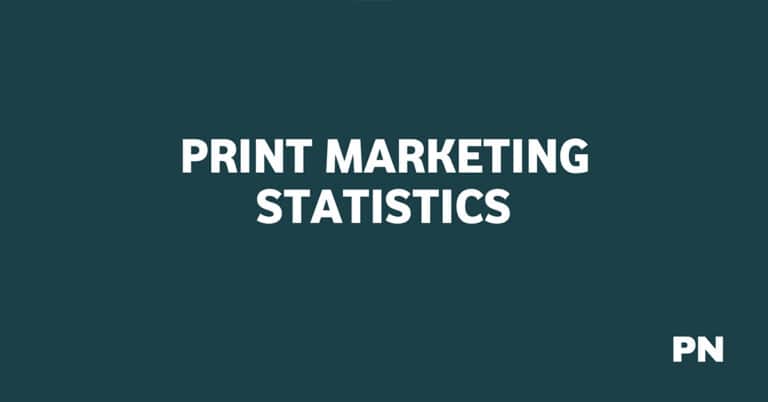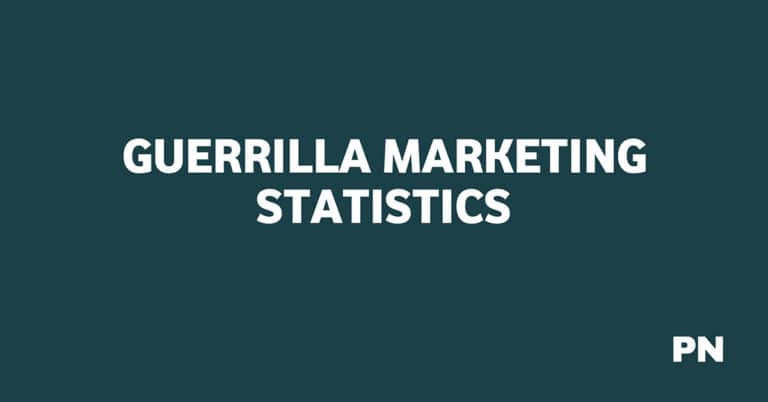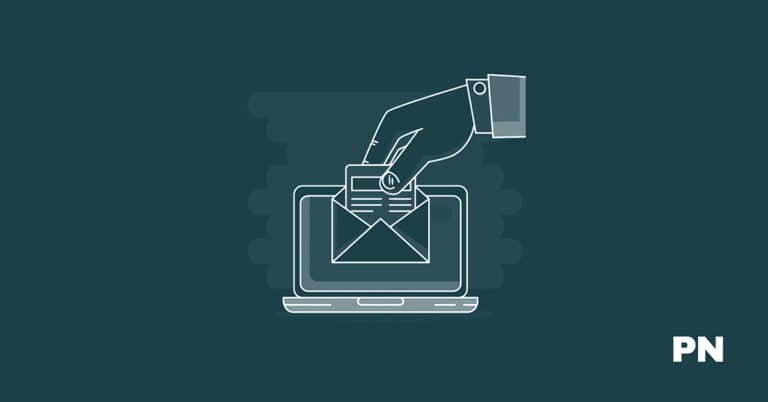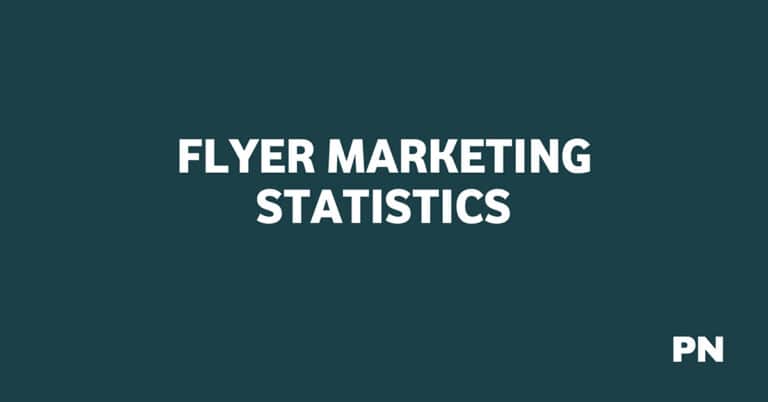38 Vital SMS Marketing Statistics & Texting Trends

SMS marketing has transformed how businesses reach consumers, with an impressive 98% open rate bolstering its effectiveness.
Amid this rapid growth, over 80% of North Americans engage with text messaging, yet a mere 35% of brands harness a formal SMS strategy.
SMS marketing’s efficiency and directness drive consumer engagement and subsequent revenue, with 96% of marketers attributing increased revenue to text message strategies.
1. Over 80% of North Americans use text messaging.
(Source: InfoCision)
This high percentage indicates that text messaging is not only widely accessible but also a preferred means of communication for the majority.
A large number of companies incorporate SMS marketing into their customer engagement plans.
Also, many consumers often check their messages shortly after receiving a notification, which enhances the reach and immediacy of SMS marketing campaigns.
Businesses analyze texting behavior to refine marketing strategies, optimizing timing and content to align with when users are most likely to engage with text messages.
Such data-driven practices further underline SMS’s importance as a marketing channel in North America.
2. Only 35% of Brands Have a Formal SMS Messaging Strategy in Place.
(Source: SlickText)
A formal SMS messaging strategy involves a well-defined plan that includes setting goals, targeting the right audience, crafting compelling messages, and measuring the impact of text message campaigns.
It also includes compliance with regulations, such as obtaining consent and respecting opt-out requests.
The absence of a formal strategy suggests that many brands could be missing out on the benefits of SMS marketing, such as:
- High engagement rates: SMS messages have been known to have higher open rates than other digital communication forms.
- Immediate reach: Text messages are typically read within minutes, making it a swift channel for reaching consumers.
- Direct communication: SMS allows brands to reach customers personally and directly in their pockets.
3. The SMS marketing industry will be worth over $12.6 billion by 2025.
(Source: Grand View Research)
The compound annual growth rate (CAGR) from 2019 to 2025 is a robust 20.3%.
Increasing numbers of mobile users are the core facilitators of this growth.
Most marketers use SMS because text messaging provides prompt and accessible customer communication.
Consumers are receptive, with millions agreeing to receive advertisements via SMS, and this number is forecasted to grow.
Marketers recognize SMS’s potential in the digital marketing era, as evidenced by their readiness to allocate more resources to text message marketing strategies.
4. The media and entertainment segment is predicted to have a CAGR of 22%.
(Source: Grand View Research)
This segment has embraced SMS as a critical communication tool, reaching audiences with various content, from movie and TV program promotions to alerts for upcoming events.
Retail businesses have typically led the usage of SMS marketing, but a significant shift is occurring.
The media and entertainment industry is quickly catching up, capitalizing on the direct and personal nature of SMS for engaging consumers.
Moreover, this uptick is also fuelled by the ease of integrating SMS with other digital marketing strategies, thereby providing a seamless consumer experience.
5. SMEs are expected to exhibit a more than 23% CAGR.
(Source: Grand View Research)
SMS marketing is relatively low-cost compared to other mediums, making it accessible for smaller budgets. SMEs can quickly send out promotions or updates, which is crucial for time-sensitive offers.
Customers opting for SMS alerts are likelier to engage with the content, increasing potential sales conversions.
Given the accessibility and reach of SMS marketing, SMEs stand to benefit significantly from this growth trend. They can utilize the immediacy of text messaging to compete with larger entities in the marketing domain effectively.
Considering the upward trajectory, SMEs should regard SMS marketing as a potentially lucrative marketing mix component.
6. About 33% of Marketers Expect to Prioritize a Mobile Loyalty Program Next Year.
(Source: SlickText)
Mobile loyalty programs are not just a trend; they reflect a growing recognition of the value of direct customer engagement through mobile devices.
By using SMS platforms, businesses can directly send targeted promotions, updates, and personalized messages to customers who opt into their programs.
SMS marketing facilitates immediate and personal consumer interaction, increasing engagement.
Many consumers prefer receiving communication via text, finding it a convenient and non-intrusive method.
By prioritizing mobile loyalty programs, marketers aim to leverage the following advantages:
- Increased Customer Retention: Regular, value-adding communication fosters customer loyalty and retention.
- Higher Conversion Rates: Timely, relevant offers sent through SMS can potentially boost conversion rates.
Marketers’ projected focus on mobile loyalty programs reflects the efficiency of SMS marketing in fostering long-term customer relationships.
7. 90% of consumers respond to a text within 30 minutes of receiving it.
(Source: Business Wire)
This rapid engagement offers marketers a palpable advantage, given that other forms of communication, such as emails or sales calls, often lack such immediacy.
Consumer Behavior with Text Messages:
- Immediate Attention: 81% of consumers check their phones for notifications within five minutes of receiving a text.
- Quick Responses: Roughly 50% of consumers reply to an SMS within three minutes.
- Frequent Checks: Most individuals check their messages over ten times daily, keeping SMS at the forefront of their communication channels.
- Engagement Levels: Compared to long-established tactics like cold calls, which have a conversion rate of 1%, text message marketing boasts a conversion rate as high as 15%.
Businesses implementing SMS strategies can potentially see an uptick in engagement due to these consumer tendencies.
SMS marketing can generate significant revenue, thanks to the medium’s capacity to reach customers effectively and foster quick communication.
Marketers looking to capture consumers’ attention promptly can rely on SMS marketing.
8. The average open rate for text message marketing is 98%.
(Source: SlickText)
Mobile phones are ubiquitous and deeply integrated into daily life, which contributes to the effectiveness of SMS marketing.
This illustrates a clear preference for SMS as a mode of communication between businesses and consumers.
High open rates suggest that SMS is a powerful tool for marketers aiming to reach their audience directly.
You should consider that a high open rate does not automatically translate to a successful conversion rate. However, it lays down a strong foundation for engagement.
Customers tend to read and respond to text messages within 3 minutes of receipt, emphasizing the immediacy and personal touch that SMS marketing encapsulates.
As companies seek to leverage this high engagement, crafting open messages and compelling the reader to take action is crucial.
9. Over 50% of Consumers Purchase a Product from a Marketing Text.
(Source: Attentive Mobile Consumer Report)
Consumers have preferred the convenience and immediacy of SMS messages, partially explaining the high conversion rates.
Text messages tend to be short and direct, offering consumers quick deals that are easy to act upon.
The following points illustrate the effectiveness of SMS marketing in driving consumer purchases:
- Immediate Reach: Nearly 90% of SMS messages are read within three minutes, capitalizing on impulsive buying tendencies.
- High Engagement: With an average open rate of 98%, SMS outperforms other marketing channels like email.
- Consumer Preference: A significant percentage of consumers have preferred receiving offers via SMS over other platforms.
Given these factors, businesses have harnessed SMS marketing as a valuable component in their overall marketing strategy to drive sales and customer engagement.
Consequently, consumers have become increasingly accustomed to receiving and acting on promotions delivered directly to their mobile devices.
10. 96% of marketers report that using text messages helped them drive revenue.
(Source: Attentive)
Text messages offer a unique immediacy and high engagement rate that other digital marketing channels often cannot match.
Importantly, this percentage suggests a near-universal acknowledgment of the efficacy of SMS marketing within the industry.
The medium’s impressive open rates support the high revenue-driving capabilities through SMS marketing.
Moreover, the conversion potential following these openings is substantial, with over 50% of consumers reportedly purchasing after receiving a marketing text.
This suggests that SMS campaigns translate directly into sales when crafted with clear calls to action.
Another factor underscoring the success of SMS in marketing is consumer preference.
A notable majority of people clearly prefer using native SMS applications on their mobile devices over other messaging platforms like Facebook Messenger or WhatsApp.
This preference also speaks to the comfort level and trust consumers place in text messaging as a communication medium.
11. Texted coupons are redeemed 10 times more often than traditional coupons.
(Source: Fun Mobility)
The allure of SMS-based promotions lies in their inherent convenience and immediacy.
Recipients can act on a discount or offer instantly instead of physical coupons, which they must remember to bring along and present at the point of sale.
Highlights from recent findings include:
- Texted coupons boast a conversion rate increase, driven by a 32% response rate from SMS recipients.
- The redemption of mobile coupons demonstrates higher incidence rates and suggests a greater influence on purchasing decisions.
- In contrast to the high engagement rates of SMS, email communications have a marked spam perception, with close to 50% of emails being filtered as spam, further emphasizing the impact of text messaging as a marketing channel.
Given these insights, marketers are aptly leveraging the power of SMS to enhance customer engagement and drive sales.
With text message marketing continuing to grow in popularity, businesses are tapping into the direct line that mobile phones provide to consumers.
12. SMS Marketers Generate $71 for Every Dollar Spent.
(Source: Oberlo)
SMS marketing has emerged as a highly effective channel with a significant ROI.
This ROI outshines many other marketing avenues, underscoring the efficiency and potential of SMS as a tool for reaching customers.
SMS marketing’s cost-effectiveness is noteworthy because sending large messages incurs relatively low expenses.
When we compare the cost to the revenue generated, it becomes clear why businesses prioritize this marketing channel.
These campaigns yield a high ROI and contribute significantly to a company’s total online revenue.
It is important for businesses to consider integrating SMS marketing into their broader marketing strategy to capitalize on its proven benefits.
13. 47% of businesses across sizes and industries use mobile messaging.
(Source: PwC – Esendex)
The adoption of mobile messaging by different sizes of businesses highlights its effectiveness as a direct and personal way to interact with customers.
Large enterprises may benefit from SMS’s wide reach and immediacy, while SMEs can capitalize on the personalized engagement that SMS marketing fosters.
This mode of marketing is resonating across various industries with its ability to cut through the noise of more saturated communication channels such as email.
Many businesses recognize mobile messaging as a cost-effective, high-engagement tool suitable for various marketing activities, from promotions to customer service.
14. Real Estate is the Top Industry Using SMS Marketing at 17.9%.
(Source: UESB)
This statistic signifies that roughly one in five real estate companies capitalizes on SMS’s direct and personal nature to engage with clients.
Real estate businesses are increasingly adopting SMS marketing because of its immediacy and high engagement rates.
SMS provides a quick and efficient way to send property alerts, updates, and appointment reminders to potential buyers or renters.
Real estate companies effectively enhance their outreach and service provision by leveraging SMS marketing’s high open rates and quick response times.
Consequently, this strategy positions them at the forefront of customer engagement within the sector.
The robust adoption of SMS among real estate professionals underscores the utility and growing significance of mobile messaging in contemporary marketing practices.
15. 46% of finance/banking companies have increased their SMS marketing spend in the past three years.
(Source: PwC – Esendex)
The allocation of more resources toward SMS initiatives suggests a strategic push towards more personalized and instant communication methods.
Financial entities are expanding their strategies and investing more substantial amounts into these campaigns.
Given SMS’s competitive edge and reach, financial institutions will likely continue to invest in this marketing channel.
Despite the surge in spending, these companies are likely seeking to optimize customer engagement and satisfaction, which are integral to success in the financial industry.
16. 25% of businesses use SMS marketing for its efficiency/effectiveness.
(Source: PwC – Esendex)
In an environment where immediacy drives consumer behavior, SMS marketing capitalizes on direct access to consumers through mobile phones.
Businesses appreciate the straightforward nature of SMS marketing.
Unlike more complex marketing channels, text messages are simple to create and send. They do not require intricate design work, leading to faster campaign deployment.
SMS marketing also offers a personal touch; text messages are often perceived as more personal than other types of advertising. This can foster a greater connection between a business and its customers.
17. 91% of consumers are interested in receiving texts from businesses.
(Source: Business Wire)
Businesses have recognized these preferences, and a growing number are utilizing SMS to engage with their customer base.
They focus on sending texts that provide value, such as:
- Exclusive discounts and offers
- Important updates and announcements
- Customer support and feedback invitations
However, with the substantial interest, businesses also have a responsibility to ensure relevance and personalization in their SMS marketing strategies.
Consumers are willing to engage but expect messages that resonate with their needs and preferences.
18. An estimated 64% of SMS subscribers feel “curious” about new texts.
The emotional response triggered by a new message notification plays a critical role in the effectiveness of SMS campaigns.
While 27% of recipients report feeling happy and 23% feeling excited, there is a lower percentage, 17%, who experience anxiety, and merely 15% who feel annoyed.
The diverse emotional reactions suggest that most recipients tend to engage with the content of the text messages positively or with curiosity. This signifies an openness to what the message might contain.
These reactions are vital for businesses thinking of using SMS as a marketing channel, not only because of the high open rates but also because of the emotional engagement they invoke in consumers.
19. Most consumers (58%) say texting is the best way to reach them.
(Source: Business Wire)
The immediacy and convenience of texting cater to the instant gratification consumers often seek.
Unlike emails, which may remain unopened, texts typically receive prompt attention.
Businesses are taking note of these preferences, with around 39% incorporating SMS messaging into their communication strategies.
The role of texts extends beyond promotional campaigns, proving instrumental for reminders and scheduling and enhancing operational efficiency.
20. 56% of consumers say, “Texting is a convenient way to reach me no matter where I am.”
(Source: EZ Texting)
This preference underscores the value they place on the accessibility of texting as a medium that connects them with brands, irrespective of their location.
Consumers lean towards quick and straightforward interactions with businesses.
As a result, companies can leverage SMS marketing to meet customer expectations for direct and efficient communication.
21. 77% of consumers positively perceive companies that keep them informed.
(Source: Mobile Marketing Watch)
With clear, concise, and prompt messaging, businesses utilizing SMS can foster a more engaged and informed customer base. This can lead to an enhanced perception of the company’s commitment to service excellence.
22. 90% of Customers Have Gained Value from SMS Loyalty Programs.
(Source: Score)
The effectiveness of SMS in loyalty programs can be attributed to its direct and instant communication capabilities.
Customers appreciate the convenience and are more likely to engage with brands offering personalized, timely SMS rewards.
Text messages typically have a higher open and read rate than emails, which can be easily overlooked.
The acceptance and value that customers derive from SMS loyalty programs are underscored by their willingness to engage.
Businesses that leverage SMS in their loyalty strategies often see heightened customer satisfaction and loyalty levels.
23. SMS marketing lists have 10x value over email marketing lists.
(Source: Mobile Marketing Watch)
Many consumers prefer text messages over emails due to their convenience and immediacy.
Text messaging is often perceived as a more personal communication, enhancing customer relations.
Additionally, the opt-out rates for SMS subscriptions are typically lower than email, with less than 5% of subscribers choosing to leave.
Given these statistics, marketers increasingly recognize the importance of building and maintaining robust SMS subscriber databases.
As such, businesses are inclined to invest more resources into SMS marketing strategies to capitalize on these advantages.
24. SMS messages deliver an average click-through rate of 19%.
(Source: Text Republic)
The higher CTR indicates that recipients of SMS marketing messages are more likely to engage with the content. They click on links at a rate nearly quadruple that of email marketing links.
SMS messaging is an effective marketing tool because of its direct reach and immediacy, which contribute to its impressive engagement rates.
25. SMS open rates average around 82%, while email open rates are about 21%.
(Source: Shift)
The stark difference can be attributed to the immediacy with which SMS messages are typically read.
Text messages are often seen and read within minutes of receipt, significantly driving up the open rates.
With individuals frequently checking their phones, SMS becomes a compelling option for marketers aiming for timely engagement.
26. Fewer than 5% of SMS subscribers ever unsubscribe, while 20% of email subscribers leave yearly.
Retention of subscribers plays a crucial role in the longevity and effectiveness of marketing strategies.
The relatively stable SMS subscriber base provides businesses with an ongoing opportunity to communicate and engage with their audience.
SMS marketing’s higher retention rate could be due to its concise messaging, perceived immediacy, and direct reach to the customer.
These characteristics might contribute to a more positive reception among subscribers, reflecting the less frequent opt-outs from SMS services.
Email marketing, although still a viable strategy, faces a challenge with a 20% annual unsubscribe rate.
Consumers may be more inclined to unsubscribe due to the higher volume of emails received or the perception that emails are less personal than text messages.
27. Sending a text follow-up to an email increased open rates by 20-30%.
(Source: Adobe)
Sending a text message as a follow-up to an email is not merely a secondary touchpoint but a powerful driver of engagement.
SMS Follow-Up Tactics Include:
- Automation: Set an automated SMS to trigger after email dispatch.
- Personalization: Include the recipient’s name and relevant details to increase the relevance.
- Brevity: Keep the text concise to ensure it’s read and acted upon.
Businesses harnessing this dual-channel approach are not just casting a wider net but are also fine-tuning the customer experience.
28. 78% of Buyers Use Their Phones to Check, Send, and Respond to Text Messages.
(Source: Kenect)
Texting remains a dominant communication channel, especially due to its convenience and accessibility.
Businesses leverage this by tailoring promotions, updates, and alerts to suit a text-based format that caters to the communication habits of their audience.
SMS marketing campaigns are calibrated to adapt to these behaviors, ensuring that messages are brief and elicit the desired action from the consumer.
29. Around 34% of Businesses Began Using SMS Marketing During the Pandemic.
(Source: ZipWhip)
Businesses swiftly incorporated SMS into their marketing mix, recognizing not only its reach but also the efficiency of the medium.
As customers spend more time on their phones, SMS provides a direct and personal communication channel.
It facilitated timely updates on changing business operations, delivery options, and health and safety measures.
Furthermore, the increased reliance on e-commerce and online services amplified the need for instantaneous customer service, which SMS could facilitate.
Customer engagements via text messaging enabled businesses to provide quick responses, enhancing customer satisfaction and loyalty during a critical time.
30. The Average SMS Marketing Response Rate Is an Impressive 45%.
(Source: Gartner)
The numbers suggest that SMS marketing’s strength lies in its pervasive reach and immediacy.
Customers often carry their mobile devices throughout the day, translating to quick access and nearly instantaneous reads.
Marketers leveraging SMS must craft concise, relevant, and valuable messages to maintain this level of engagement.
31. 55% of people prefer using SMS over Facebook Messenger and WhatsApp.
(Source: EZ Texting)
Businesses note that integrating SMS into their communication strategies has been beneficial.
Unlike Messenger and WhatsApp, which require the installation of an app, SMS is inherently present on mobile devices, which may explain its continued dominance in the communication arena.
32. 33% of SMS recipients react to CTAs in marketing messages, and 47% purchase.
Considering the nature of SMS marketing, businesses can leverage the high open rates of text messages to amplify their reach and potentially increase their sales.
Crafting CTAs that are clear, compelling, and easy to act on is crucial, as these factors can significantly influence the likelihood of eliciting a positive response from recipients.
The response and conversion rates associated with CTAs in SMS marketing highlight the power of personalized, direct communication in driving sales and customer engagement.
33. E-commerce brands witness impressive SMS marketing click-through rates, with figures soaring as high as 36%.
E-commerce brands are tapping into the efficacy of SMS marketing with click-through rates (CTR) that significantly outperform many other marketing channels.
These numbers suggest that a substantial portion of recipients are engaging with text message marketing content.
The reasons behind such high engagement rates may include the personal and immediate nature of SMS.
This upswing in SMS click-through rates illustrates a growing trend in consumer responsiveness to mobile marketing.
It affirms the potential SMS marketing holds for e-commerce retailers who seek effective ways to connect with their audience.
34. Coca-Cola allocates 70% of its mobile marketing budget to SMS marketing.
Coca-Cola, a global leader in the beverage industry, strategically dedicates a substantial portion of its mobile marketing budget to SMS marketing.
Given the consumer’s proximity to mobile devices, SMS is a direct line to customers, ensuring timely and personalized communication.
Coca-Cola leverages this by distributing announcements, promotions, and engaging content directly to consumer phones, optimizing for immediacy and interaction.
35. It takes about 90 seconds for someone to reply to a text message and around 90 minutes to respond to an email.
(Source: Mindful)
The immediacy of SMS makes it a powerful channel for marketing communications, where prompt responses are often vital for customer engagement and conversion.
The data supports including text message marketing in a comprehensive strategy for reaching customers efficiently and effectively.
36. 65% of consumers get between 6 to 21 business emails daily.
(Source: EZ Texting)
Every day, many consumers’ inboxes are filled with emails from various businesses.
Most businesses default toward using email as a primary tool for marketing.
However, the high email volume poses the risk of consumers experiencing email fatigue.
As such, businesses must strive to create compelling and relevant content to maintain the efficacy of their email marketing campaigns.
Ensuring that emails are targeted and personalized can help them stand out amidst consumers’ daily emails.
37. With an estimated 7.5 billion mobile users anticipated by 2025, the SMS market is poised for further expansion.
The anticipated expansion of the mobile user market sets the stage for considerable growth in SMS marketing.
Companies are positioned to harness this channel’s potential, tailoring their strategies to meet the demands of a growing mobile landscape.
38. 85% of interactions between brands and customers will be managed without speaking.
(Source: Gartner)
Customers value the ease of sending and receiving messages according to their schedules. Many consumers prefer texting over calls as it is less intrusive and allows time to consider responses.
Automated systems can handle inquiries and transactions faster than human operators.
Hence, brands must integrate SMS into their marketing strategies to meet customer expectations.
Final Thoughts on SMS Marketing Statistics
As data reflects, SMS marketing is an increasingly powerful channel for engaging consumers.
The number of businesses adopting SMS marketing strategies is noteworthy, with 53% already utilizing mobile messaging and an additional 31% planning to do so within the year.
Given these statistics, companies are advised to harness the concise and direct nature of SMS.
Furthermore, they should be mindful of the message volume, as most consumers receive texts from 1-3 businesses but are open to 4-6.
Effective SMS marketing thus requires strategic planning, respecting consumer preferences, and delivering value through each message.
Disclosure: We may earn commissions if you buy via links on our website. Commissions don’t affect our opinions or evaluations. We’re also an independent affiliate of many platforms, including ClickFunnels, Kartra, GoHighLevel, Podia, Northwest Registered Agent, and others. We’re not employees of these services. We receive referral payments from them, and the opinions expressed here are our own and are not official statements of these companies.





